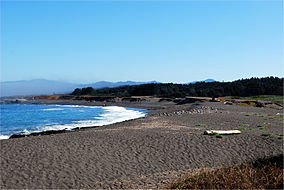geo.wikisort.org - Coast
MacKerricher State Park is a state park in California in the United States. It is located 3 miles (4.8 km) north of Fort Bragg in Mendocino County. It covers 9 miles (14 km) of coastline and contains several types of coastal habitat, including beaches, dunes, headlands, coves, wetlands, tide pools, forest, and a freshwater lake.[1]
| MacKerricher State Park | |
|---|---|
 | |
  | |
| Location | Mendocino County, California |
| Nearest city | Fort Bragg, California |
| Coordinates | 39°29′36″N 123°47′37″W |
| Area | 2,299 acres (930 ha) |
| Established | 1952 |
| Governing body | California Department of Parks and Recreation |

Natural features
The northern coastline of the park is a long, sloping beach, and the southern section is made up of rocky cliffs and flats separating smaller strips of beach. Inland from the ocean is Lake Cleone, a former brackish marsh that was closed off by the construction of a road and became a 30-acre (12 ha) freshwater lake. Much of the northern section of the park is occupied by the Inglenook Fen Ten Mile Dunes Preserve, a sensitive dune complex with wetland and terrestrial vegetation zones. Laguna Point is a peninsula near the middle of the park. The Ten Mile River marks the upper boundary of the park, and several creeks drain run through the landscape and into the Pacific Ocean.[1]
The headlands are covered in grasses and wildflowers. Wooded areas just inland have stands of bishop pine (Pinus muricata), shore pine (Pinus contorta), and Douglas fir (Pseudotsuga menziesii).[1] The park contains 95% of the entire distribution of the rare Mendocino spineflower (Chorizanthe howellii), which grows in the protected dunes of the Inglenook Preserve.[2] Animals in the area include harbor seals, which haul out on the rocks to sun. Gray whales on their annual migration are visible from shore between December and April, providing whale watching opportunities. Other mammals include black-tailed deer, raccoons, gray foxes, and occasionally mountain lions. There are many forms of tide pool life. There are more than 90 species of birds, including migratory waterfowl and permanent residents such as ospreys, great blue herons, ring-necked ducks, and mallards.[1] The tidewater goby (Eucyclogobius newberryi) is an endangered species of fish that lives in the local creeks and rivers. Some of these waterways were recently designated as critical habitat for the fish, and the park may be expanded to preserve it.[3]
History
Indigenous peoples of California, including the Pomo and Yuki peoples, lived in or traveled through the region, utilizing resources such as seaweed, shellfish, and acorns.[1] The Mendocino Indian Reservation was established in the area. Canadian newlyweds Duncan and Jessie MacKerricher moved to the area in 1864.[4] They hired a staff of native people to work on their ranch, which produced butter, potatoes, and draft horses.[5] In 1949, their descendants sold the MacKerricher property to the state of California, which made it a state park.[1]
Recreation
Parks staff leads hikes and whale-watching ventures. It maintains campgrounds and other facilities. Lake Cleone is available for fishing. There are trails for walking, cycling, and horseback riding.[1]
Glass Beach, at the southern end of the park, is famous for its fields of sand-polished glass pebbles. They are remnants of garbage that was piled on the beach when it was used as a dump by area residents in the 1950s and 1960s. After decades of friction in the tides, the discarded, broken glass has been reduced to smooth, attractive trinkets sought by casual collectors.[6]
See also
- List of beaches in California
- List of California state parks
- Virgin Creek, a stream whose mouth is within the park
References
- MacKerricher State Park Brochure. Archived 2013-12-03 at the Wayback Machine California Department of Parks and Recreation. Rev. 2012.
- Chorizanthe howellii 5-Year Review: Summary and Evaluation. United States Fish & Wildlife Service, Arcata. September 2007.
- Hartzell, F. Changes coming to Inglenook Dunes Preserve. Fort Bragg Advocate-News April 11, 2013.
- "MacKerricher Family History". mendocino.com. Retrieved 2021-09-21.
{{cite web}}: CS1 maint: url-status (link) - State Parks of the Mendocino District: MacKerricher. California State Parks, Mendocino District.
- Reynolds, C. The fetid underbelly of Glass Beach. Los Angeles Times August 3, 2004.
External links
- MacKerricher State Park California Department of Parks and Recreation
Другой контент может иметь иную лицензию. Перед использованием материалов сайта WikiSort.org внимательно изучите правила лицензирования конкретных элементов наполнения сайта.
WikiSort.org - проект по пересортировке и дополнению контента Википедии